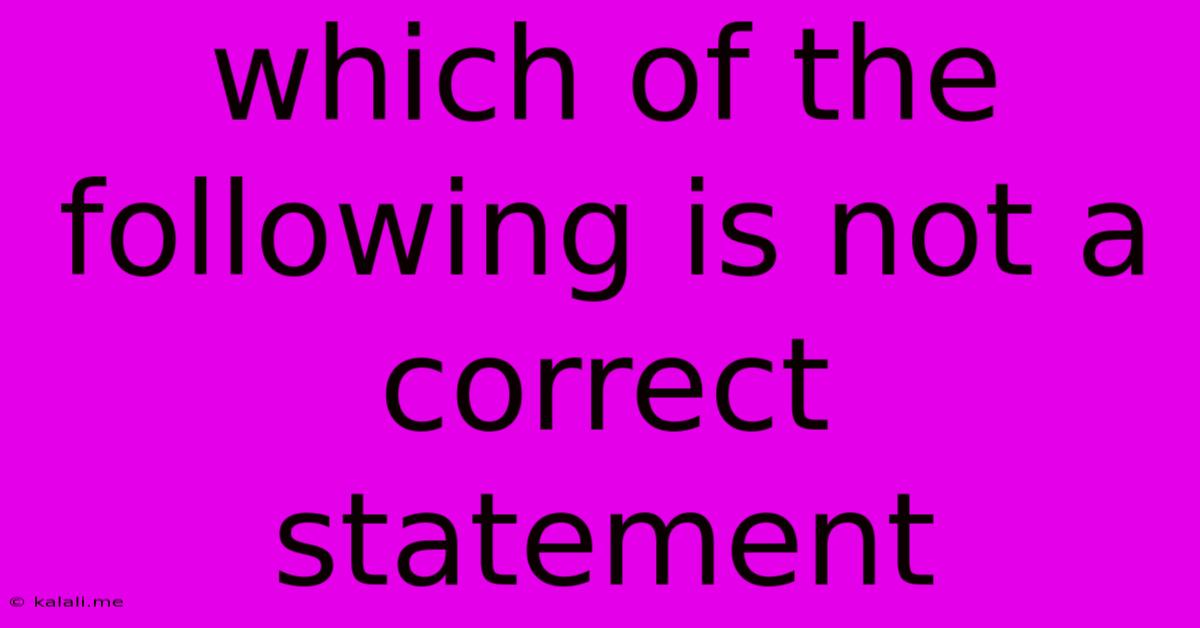Which Of The Following Is Not A Correct Statement
Kalali
Jun 15, 2025 · 3 min read

Table of Contents
Which of the Following is NOT a Correct Statement? A Guide to Identifying Falsehoods
Identifying incorrect statements is a crucial skill, whether you're tackling a multiple-choice test, evaluating research, or simply navigating daily information. This article will explore strategies for determining which statement among a set is false, focusing on critical thinking and logical reasoning. This is particularly important in an era of misinformation, where discerning truth from falsehood is paramount.
What Makes a Statement Incorrect?
An incorrect statement deviates from factual accuracy, logical consistency, or established principles. It could contain:
- Factual inaccuracies: Statements contradicting verifiable facts or evidence.
- Logical fallacies: Errors in reasoning that render the conclusion invalid.
- Ambiguity or vagueness: Statements that are unclear or open to multiple interpretations.
- Contradictions: Statements that conflict with themselves or other established information.
- Unwarranted assumptions: Statements that rely on unproven or improbable assumptions.
Strategies for Identifying Incorrect Statements:
When presented with a list of statements, employ these strategies:
1. Understand the Context
Before evaluating the statements, carefully consider the context. The subject matter, the source of the statements, and any accompanying information are crucial for accurate assessment. Understanding the context helps you interpret the statements correctly and identify potential biases or inaccuracies. For example, a statement that is true in a specific historical context might be false in another.
2. Check for Factual Accuracy:**
Verify the factual claims in each statement. Use reputable sources to check for consistency. If a statement contains a numerical fact, date, or specific detail, you can readily confirm or refute it. Remember to be wary of sources with known biases.
3. Analyze for Logical Fallacies:**
Look for flaws in reasoning. Common logical fallacies include:
- Straw man: Misrepresenting an opponent's argument to make it easier to attack.
- Ad hominem: Attacking the person making the argument rather than the argument itself.
- Appeal to authority: Accepting a claim as true solely because an authority figure said so.
- False dilemma: Presenting only two options when more exist.
- Hasty generalization: Drawing a conclusion based on insufficient evidence.
4. Examine for Ambiguity and Vagueness:**
Statements with unclear language or multiple interpretations are often incorrect or misleading. If a statement is vague, it's difficult to ascertain its truthfulness. Look for words with multiple meanings or sentences with unclear grammatical structure.
5. Identify Contradictions:**
Check if any statement directly contradicts another statement in the list or contradicts established facts or principles. A contradiction immediately signals an incorrect statement.
6. Evaluate Assumptions:**
Identify any underlying assumptions in each statement. If a statement relies on unproven assumptions, it’s likely incorrect. Ask yourself: What must be true for this statement to be correct? If the necessary assumptions are not supported by evidence, then the statement is likely false.
7. Cross-Reference with Reliable Sources:**
Use multiple reputable sources to cross-check information presented in the statements. This helps to build a more comprehensive and accurate understanding of the topic.
Conclusion:
Identifying incorrect statements is a process requiring careful analysis, critical thinking, and a reliance on credible sources. By applying the strategies outlined above, you can enhance your ability to distinguish between truthful and false information, fostering better decision-making and a more informed understanding of the world. Remember to always question information, especially when significant implications are involved.
Latest Posts
Latest Posts
-
Which Of The Following Is A Non Renewable Resource
Jun 15, 2025
-
What Is A Major Element Found In Bones
Jun 15, 2025
-
What Is The Storage Form Of Glucose In Plants
Jun 15, 2025
-
Which Is Heavier Kilograms Or Pounds
Jun 15, 2025
-
Identify The True And False Statements About Survey Research
Jun 15, 2025
Related Post
Thank you for visiting our website which covers about Which Of The Following Is Not A Correct Statement . We hope the information provided has been useful to you. Feel free to contact us if you have any questions or need further assistance. See you next time and don't miss to bookmark.